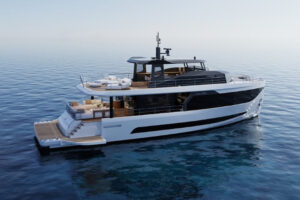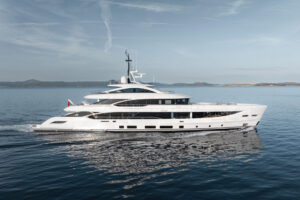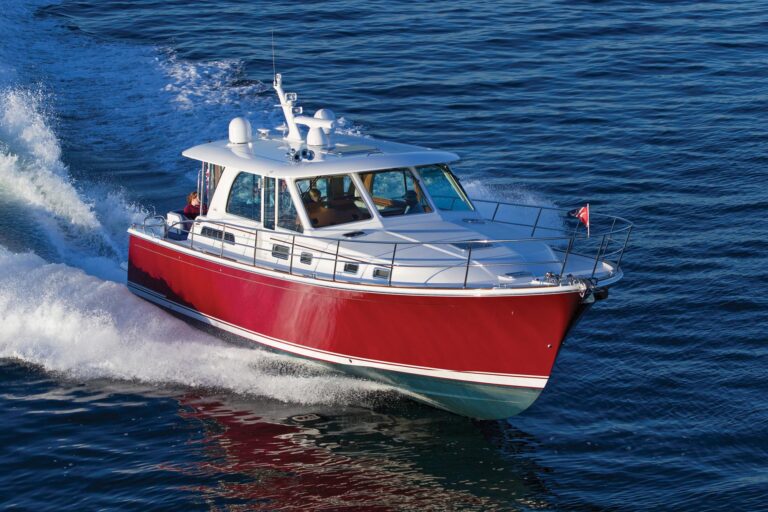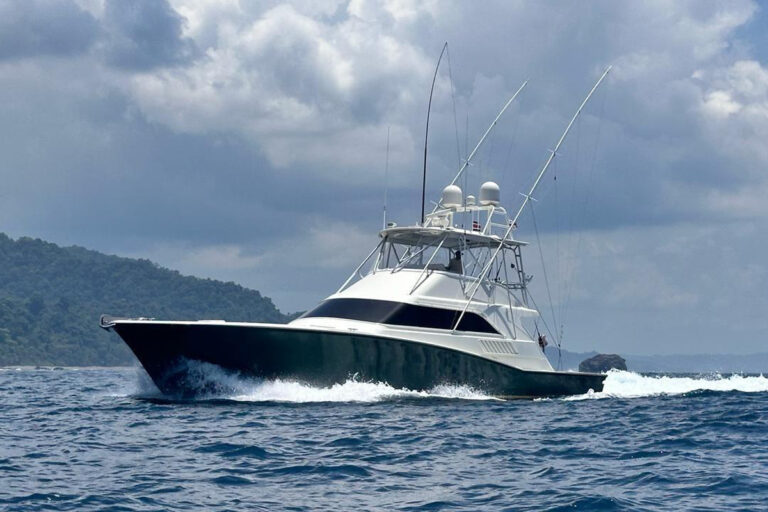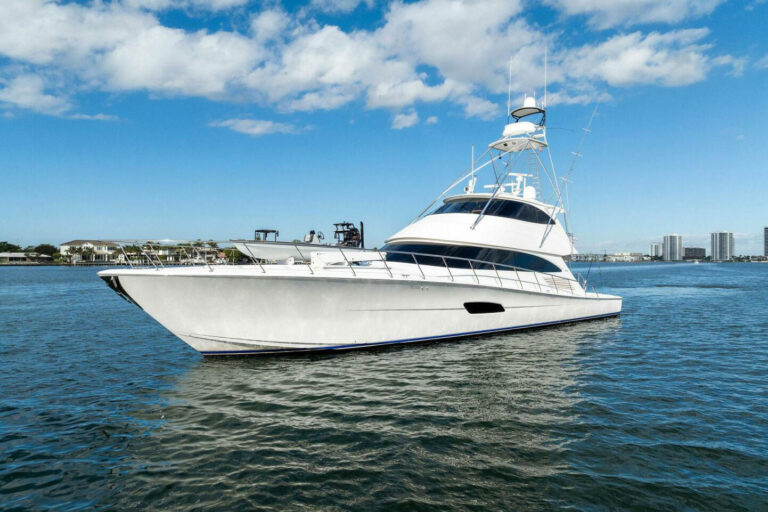The contrast to his company car couldn’t be more stark. Jeff Gordon spends his working days in NASCAR team owner Rick Hendrick’s DuPont Monte Carlo, a 200-mph racing machine wearing the number 24 and sporting so many colors that his racing team has been dubbed the Rainbow Warriors.
Gordon has won NASCAR’s premier title, the annual Winston Cup Series national championship, four times, the last in 2001. In so doing, he joined racing patriarch Richard Petty and the legendary Dale Earnhardt as the only men to have taken the crown more than three times. Interestingly, Gordon’s first Winston Cup race in 1992 was also Richard Petty’s last.
In his off time, and there’s precious little of it, Gordon understandably likes to get away from the track and the crowds. His avocation is cruising and diving, and his latest vehicle of choice for this activity is a new 106-foot trideck motoryacht. Designed and constructed by Lazzara Yachts of Tampa, Florida, 24 Karat is a showcase of flawless, sweeping curves and has lines even sleeker than those of Gordon’s Monte Carlo, but that and the name are where the similarity ends.
Although Gordon was not aboard, I visited the yacht in Ft. Lauderdale with Lazzara Yachts’ chief designer and president, Dick Lazzara. Lazzara had told me Gordon was referred to him by Roger Penske, a former motorsports driver of renown and now a team owner and yachtsman. Penske’s spectacular Feadship, Detroit Eagle (“Full Throttle, February 2002), is filled with action-packed racing art and colorful career memorabilia. Not so aboard Gordon’s 24 Karat.
Built to order with considerable input from Gordon, 24 Karat‘s interior is surprisingly subdued. The English colonial décor is reminiscent of a fine gentleman’s retreat, quite appropriate, for that is exactly what it is. It is, in essence, Gordon’s escape capsule from the world of racing celebrity.
Interior designer Chris DeLashmutt, who works exclusively for Lazzara Yachts, used cherry veneers arrayed in starburst patterns and finished in a high gloss to set the stage for furnishings and accessories that make the yacht as warm and welcoming as a trusted old friend. Patterned carpets accented by marble borders delineate the saloon and dining areas on the main deck, and marble is also used for the sole of the lower guest foyer. Brocades and other pronounced weaves are employed for upholstered furnishings to offer a textured, light-hued contrast to the smooth cherry joinery.
Gordon’s yacht is hull number two in a series of semi-custom 106-footers built by Lazzara. Hull three has already been delivered, and all utilize the builder’s innovative multipart mold system for fiberglass hulls that, while all new with extra length and beam, are derived from Lazzara’s successful earlier models, including the current 94-footer. There is a choice of standard arrangement plans, but the first three boats each have a different layout customized to her owner’s specifications.
The first yacht of the series had four staterooms and a sitting room. Gordon often hosts special guests and opted to combine the port and starboard staterooms into a luxurious, full-beam VIP stateroom. A third sizable stateroom lies at the bow, and a fourth smaller cabin/sitting room is situated to starboard.
Gone is the fuel deep tank that separated guest accommodations from the engineroom on earlier Lazzara yachts. In its place is double-bottom tankage that leaves more length forward. To counter the potential for noise transfer from the main machinery and auxiliary equipment, the master stateroom on 24 Karat is buffered by a well-insulated bulkhead and a full-beam his-and-her head that includes a spacious shower and huge tub on centerline.
Gordon’s input on the design was not limited to the arrangement and décor. Without any background in yacht design, but with a fair degree of experience from previous boats and a keen sense of the importance of mechanical technology, Gordon reportedly immersed himself in learning all he could about the yacht as it came together. His years of discipline and working with a team approach to achieve his goals were apparent, as well. Dick Lazzara described Gordon as “one of the most enthusiastic owners we’ve ever had. An open thinker and innovator himself, Lazzara recounted what a pleasure it was to work with Gordon as the yacht came together, fielding questions and incorporating suggestions Gordon brought from a different but equally high-tech perspective.
Our sea trial off Ft. Lauderdale was in small swells, not the best for testing the limits of a boat’s performance, but I was pleased with 24 Karat‘s response as I ran her through a range of speeds and maneuvers. Capt. Warwick Hallinon confirmed that she behaves equally well in heavier seas.
The yacht had little perceptible vibration, even at top speed, with no buzz at all on the afterdeck. I was particularly interested in this aspect, as 24 Karat is designed with moderate propeller tunnels to achieve her 5-foot, 6-inch draft. The tunnels, similar in shape to those used for water jet inlets, house Rolla custom machined, high-area five-blade propellers. These are running with reduced clearance between the blade tips and the hull, just 10 percent of the prop’s diameter compared with a normal clearance of 15 to 20 percent. To ensure the system would be optimized for performance and speed, Lazzara worked with Rolla in computer designing the tunnel shape and propeller specifications. Further, each shaft strut has a single foil-shaped leg to limit disturbance of the inflowing water as much as possible.
While there will be no 14-second refuelings aboard 24 Karat, the synergy between Lazzara’s yacht-building expertise and Gordon’s racing experience was readily apparent as I entered the yacht’s engineroom. It is, without a doubt, one of the best-arranged and most easily accessible spaces I have seen on a motoryacht of this size and power. Maintenance, both preventive and repairs, is facilitated by a pair of workbenches above the gensets aft and a small engineer’s station at the fuel manifold forward.
In addition, everything is labeled with lettering that leaves no doubt what any valve, switch or piece of equipment does. Helpful to crew in normal operations, such instructions become even more important in an emergency. At a glance, I could tell that the bilge manifold was lined up for draining the engineroom as soon as the pump was started. The carbon-dioxide fire system had clear actuation controls just outside the engineroom’s watertight door, and the door itself was fitted with a window so one could see what was happening in the machinery space without opening the door.
Lazzara Yachts, while always mindful of the welfare of its owners, has consistently improved the safety aspects of its yachts over the years. Gordon’s 24 Karat is one of the best yet. From small details such as the electrical interlock on the flying bridge grill cover, to larger ones like the float-free positioning of the liferaft canister, this yacht is beautiful proof that safety, comfort and aesthetics are not mutually exclusive aspirations. Form and function can indeed coexist, though Dick Lazzara laughingly protested that his Italian heritage of “beauty above all prevents him from acknowledging that possibility.
Contact: Lazzara Yachts, (813) 839-0090; www.lazzarayachts.com.


